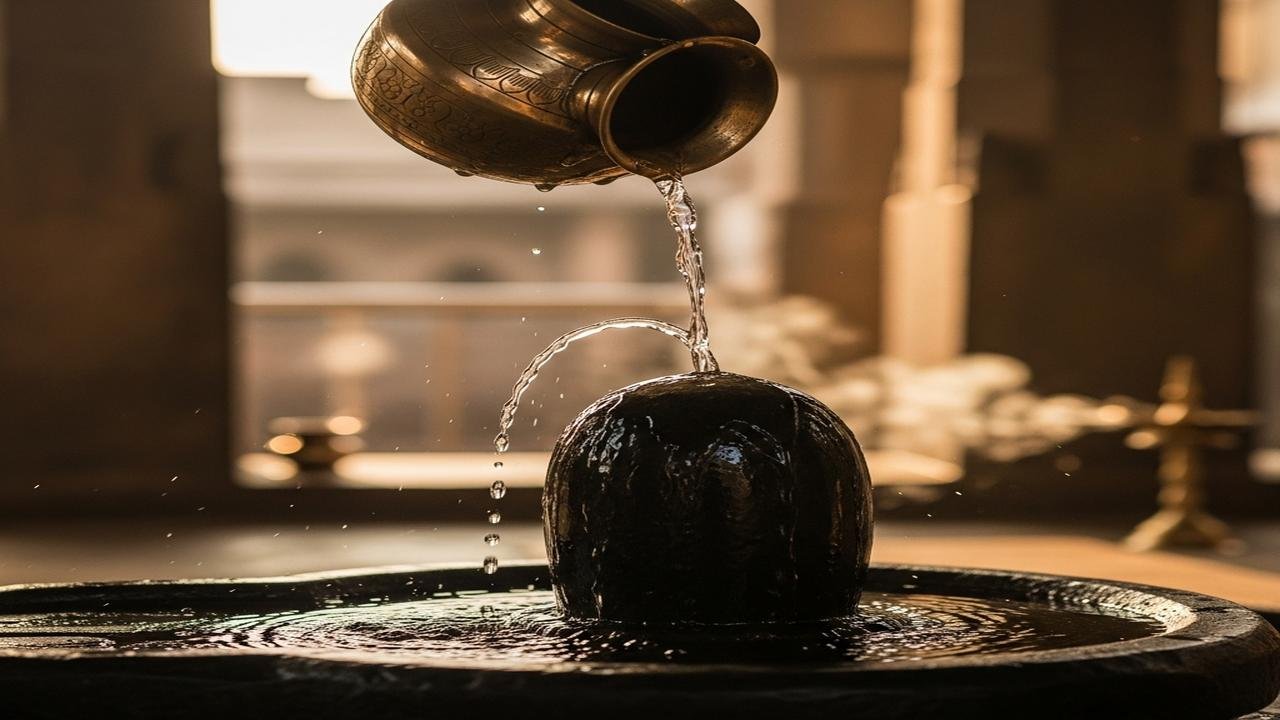Shivalinga: Why Devotees Pour Water, Take Tirtha

Why people touch the Shivalinga with water
On entering a Shiva temple many people pour water over the linga, touch the wet stone with their hands or forehead, and then sip or sprinkle that water on themselves. To an outsider this can look like a simple, repeated gesture; to devotees it is an intimate act of worship. Behind it lie layered reasons — theological, ritual, textual and practical — that different communities emphasise in different ways.
Key words
- Shivalinga — the aniconic form (sign) that represents Shiva in many temples.
- Abhisheka — ritual bathing of an image or linga.
- Tirtha — sacred water made holy by contact with a deity or shrine.
- Swayambhu — a linga believed to be self-manifested, not man-made.
- Prana-pratishta — consecration ceremony by which a murti or linga is vested with divine presence.
Ritual and textual basis
In Shaiva temple practice the ritual bathing of the linga is central. The Agama texts, which guide temple worship in many Shaiva and Smarta traditions, prescribe abhisheka as an essential seva (service) — done daily and on festivals with substances such as water, milk, curd, honey and ghee. The idea is not merely cleanliness but consecration: liquids offered to the linga are sanctified and returned to devotees as tirtha (blessed water).
Different texts and regional traditions present variations. Some Agamas give detailed sequences and materials for abhisheka; local panchayat or temple boards set the practical rules. In many temples the water used for abhisheka is considered the most direct carrier of the deity’s blessing — so touching the linga after wetting it, or receiving the drips, is a way to make that blessing physically present to the worshipper.
Symbolic meanings people often mention
- Purification: Water is a universal symbol of cleansing. In ritual terms, pouring water expresses removal of impurity and a readiness to receive grace.
- Accessibility without violation: The linga represents the divine in a concentrated form. Using water as an intermediary allows devotees to approach and receive without transgressing prescribed rules about direct handling, when such rules exist.
- Transfer of sanctity: Liquids that touch the linga become tirtha, a portable medium by which the sacred is shared — one can sprinkle it on the head, sip a drop, or take it home.
- Cosmic symbolism: Classical exegesis reads the linga as a sign of the unmanifest principle; water stands for life, consciousness or the flow of devotion that animates the static form.
Why some temples discourage or forbid direct touching
At the same time, many temples limit or prohibit devotees from directly touching the linga. Several reasons are commonly given, and often coexist:
- Ritual purity and protocol: In Agamic systems certain portions of worship are to be handled only by qualified priests after specified purificatory rites. Direct lay contact can be seen as crossing those ritual limits.
- Preservation: Ancient lingas — especially those that are centuries or millennia old, or are swayambhu — are sensitive to abrasion, oils, sweat and repeated handling. Restrictions can be conservation measures to protect the stone or metal from physical damage.
- Hygiene and crowd control: For practical reasons, including public-health concerns or simple crowd management, temples may use water or ladles rather than permitting everyone to touch the linga directly.
- Theological emphasis: Some sects emphasise inner surrender over physical contact and discourage ritual touch as secondary to true devotion (bhakti).
Hidden but practical purpose: water as mediator
One of the less obvious but important functions of touching the linga with water is that water mediates. It makes the sacred tangible while reducing the need for direct contact that might be ritually problematic or materially damaging. In other words, the “hidden” reason is not mystical alone: it is a practical compromise that preserves sanctity, grants access and protects the shrine.
When a priest or devotee pours water and a worshipper touches the wet surface or receives a sprinkle, three things happen simultaneously: a prescribed ritual act is completed (the abhisheka), the worshipper participates in darshan (seeing and contact), and a small amount of sacramental substance (tirtha) is made available. This continuity of meaning — ritual, psycho-spiritual and material — explains why the practice is so widely preserved despite varied local rules.
Variations across communities
- Shaiva temples: Often emphasise abhisheka as essential; some allow devotees to pour water while priests perform major abhishekas.
- Smarta and temple boards: May set formal restrictions, especially in large urban temples.
- Local folk traditions: In village shrines, tactile and bodily forms of devotion (touching, wiping) are more likely to continue as community practice.
How to approach this practice respectfully
- Follow the rules of the temple you visit — they express theological, conservation and practical judgments.
- If you are offered tirtha, receive it with gratitude; if the linga is off-limits, use the provided priestly or institutional channels for blessings.
- Avoid insisting on direct contact with an ancient or clearly restricted linga — preservation and community practice matter.
- If the practice involves shared water or close contact, follow local temple guidance for hygiene and safety.
Conclusion
Touching the Shivalinga with water is not a single thing but a cluster of meanings and purposes. Texts and priests frame it as ritual abhisheka; devotees experience it as a way to receive blessing and make a personal connection; temple authorities may restrict it for conservation or public-order reasons. The “hidden” reason — water as a mediator — helps explain why the gesture persists: it protects the material form, preserves ritual propriety, and at the same time carries sanctity to the worshipper. Read through any temple’s local practice, and you will find how these layers of theology, history and practicality have shaped when and how water is used in relation to the linga.
